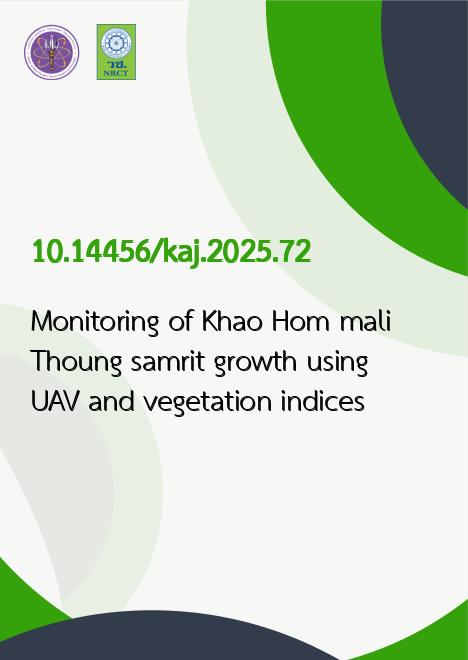
|
Monitoring of Khao Hom mali Thoung samrit growth using UAV and vegetation indices |
|---|---|
| รหัสดีโอไอ | |
| Creator | Anake Srisuwan |
| Title | Monitoring of Khao Hom mali Thoung samrit growth using UAV and vegetation indices |
| Contributor | Wassana Phanurak, Sarochinee Kaewthani |
| Publisher | Faculty of Agriculture |
| Publication Year | 2568 |
| Journal Title | Khon Kaen Agriculture Journal |
| Journal Vol. | 53 |
| Journal No. | 5 |
| Page no. | 1032-1048 |
| Keyword | Khao Hom mali Thoung samrit, UAV, vegetation indices, PCA, precision agriculture |
| URL Website | https://li01.tci-thaijo.org/index.php/agkasetkaj |
| Website title | Khon Kaen Agriculture Journal |
| ISSN | 3027-6497 (Online) |
| Abstract | The production of Khao Hom Mali Thoung samrit, a geographically indicated rice variety in Nakhon Ratchasima Province, Thailand, is constrained by limitations in yield and field management efficiency. Timely and accurate monitoring of rice growth stages is essential to support precision agriculture. This study investigated the growth of rice at the tillering, booting, and heading stages by integrating aerial imagery from an Unmanned Aerial Vehicle (UAV) with vegetation indices, namely, the Green-Red Vegetation Index (GRVI), Visible Difference Vegetation Index (VDVI), and Excess Green Index (ExG), along with rice clump height measurements in field plots. A DJI Phantom 3 Professional UAV was deployed to capture high-resolution imagery, which was processed using Agisoft Metashape to generate orthomosaic maps and compute vegetation indices. Principal Component Analysis (PCA) was employed to investigate the multivariate relationships between the vegetation indices and plant height across growth stages. Results indicated that GRVI, VDVI, and ExG reached their peak values during the tillering stage, corresponding to vigorous vegetative development and high chlorophyll content. These indices declined in subsequent stages, reflecting physiological transitions in the plants. PCA revealed that the first two components accounted for 90.21% of the total variance, with PC1 strongly associated with vegetation indices and PC2 inversely correlated with plant height. The findings underscore the potential of UAV-based remote sensing and RGB-derived indices as practical and cost-effective tools for assessing rice crop development, supporting more targeted and sustainable field interventions. |